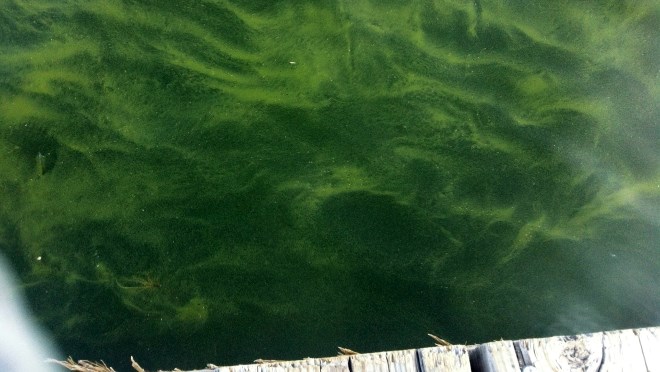The green algae blooms being reported on areas across Ramsey Lake are among the largest the city has seen in a decade, says the co-chair of the Ramsey Lake Stewardship Committee.
Elaine Porter, who has a home beside the lake in the South Bay area, said the blooms are clumping together and growing.
"Reports are that it has moved into the middle of the lake, as well,” Porter said Thursday. "It's just very large and is spread out across a large area of the lake.
"I'm in South Bay and I live on the lake and it was there over the weekend for two days, and it was like pea soup."
This summer's hot and dry weather is helping the blooms thrive, since they do well in shallower, warmer water. But even years with lots of rain are a problem as well, she said.
"When there's a lot of rain, then phosphorus is washed into the lake from the soil," Porter said. "But a big component to that is heat. The hotter it is, the more likely it is to grow."
Phosphorus gets into the water in a number of ways. While a certain amount comes from the atmosphere, lawn and garden fertilizers are another major source, and most soaps contain phosphorus.
Another source includes discharge that occurs into lakes when the city's drainage system is overwhelmed. A big reason for that are illegal hookups many residents have to the city's drainage system. And lakeside homes with septic systems can leach phosphorus into the water.
But Porter says properly functioning septic systems such as the one at her home don't threaten the lake.
"Septic systems themselves don't create many problems,” she said. “It's the ones that are not maintained. If we had more compliance with people rectifying malfunctioning septic systems, there wouldn't be a problem."
And Porter said anyone who wants to take a boat ride along Ramsey Lake will see lots of perfectly green lawns in front of homes, even though fertilizer is banned for homeowners with lakeside properties.
"There are a lot of lovely looking lawns along the lake,” she said. “Unfortunately, people are not following those guidelines. They may have a wonderful lawn, but they might lose the lake water quality in the process."
She'd like to see development banned near the lake, citing the example of the nearby development on Keast Drive, which was approved by the city and Ontario Municipal Board after area residents appealed it. Along with plans for the Kingsway Entertainment District, she said more road salt will get into Ramsey, causing further damage to the lake.
However, the developer of the Keast Drive property has said he's putting in a connection to the municipal sewer system. That means nearby homes can get off septic systems and hook up to the municipal drainage system, reducing the amount of phosphorus getting into the lake.
But even the new storm water management pond that's part of the development doesn't impress Porter, who says debris created by construction will end up in the lake. And storm water management systems can be overwhelmed, threatening the lake.
And she said added road salt destroys organisms in the soil that absorb phosphorus.
"It takes away the natural process of the lake."
Paul Javor, drainage engineer, Greater Sudbury, said he's not aware of any study that links road salt and phosphorus. But the city is putting the finishing touches on a watershed study on Ramsey Lake that should be released sometime this fall.
"But it won't tell us exactly where the phosphorus is coming from," Javor said. "Everywhere there are developed areas in the community can lead to phosphorus being release into the lake."
What the study will show, however, are the areas where water drains into the lake and the highest priorities to improve stormwater management systems.
"There will be recommendations specifically for those projects in different locations," Javor said. "As well, there will be recommendations on how to manage stormwater for new development."
That means when a development is planned for an area, the study will help guide the way in which runoff into the lake is contained.
"We're going to come up with a suite of options for our developers to utilize to do that," he said. "We're not just going to say, 'do better.' We're going to give them examples of how they can do things differently."
Some of the existing stormwater drainage management sites are 80-100 years old, Javor said, and they will be the first areas targeted for upgrades.
"That's where the city is going to focus a lot of capital investment in the coming years, and probably over a long period of time, because they will be major investments," he said. "So new development will use better techniques and technologies that suit our challenging geography."
On a smaller level, he said everyone in the city who cares about water quality can help. Seeking out soaps that don't contain phosphorus, being aware that when you fertilize your lawn or wash your car, those products contain phosphorus that will end up in the lake.
Rain barrels ensure the water doesn't go anywhere. And rain gardens, where gutters are directed into an area where it can absorb into the ground, can help, too.
"The city can only do so much,” Javor said. “Every homeowner owns a part of the watershed, so there's an opportunity for everyone to have a positive impact."
